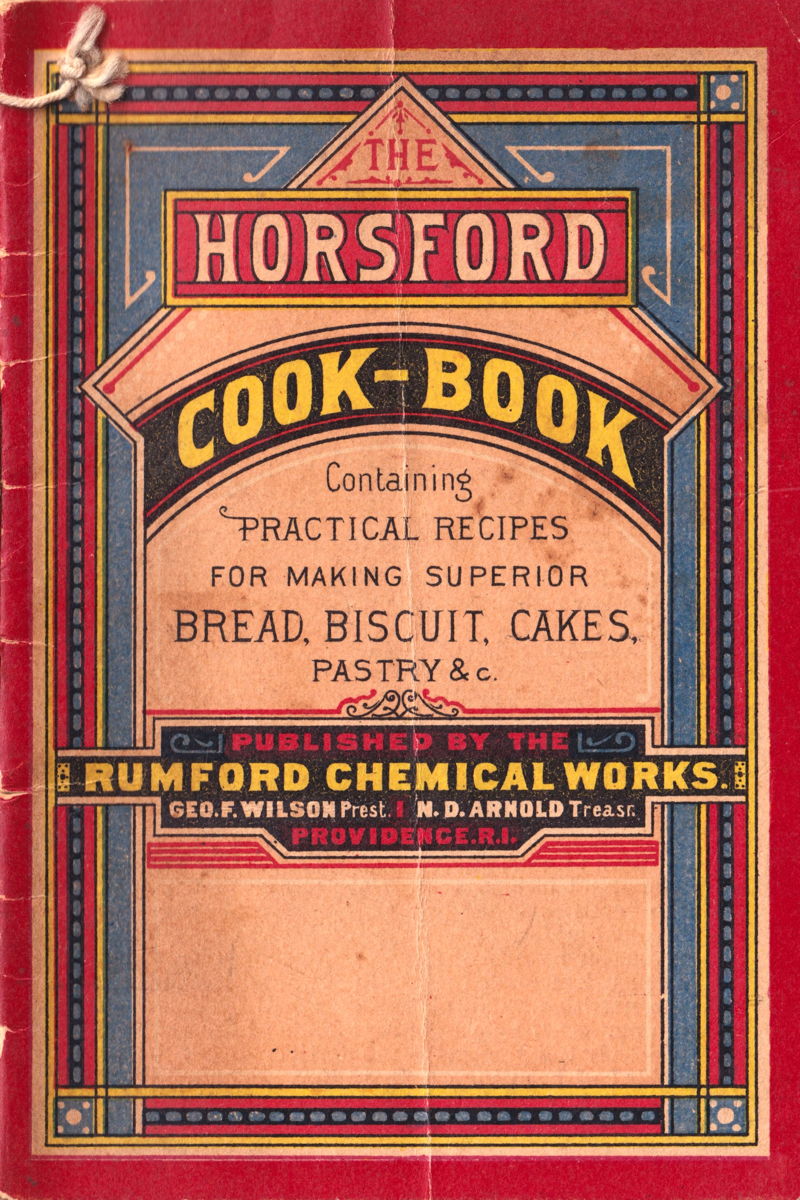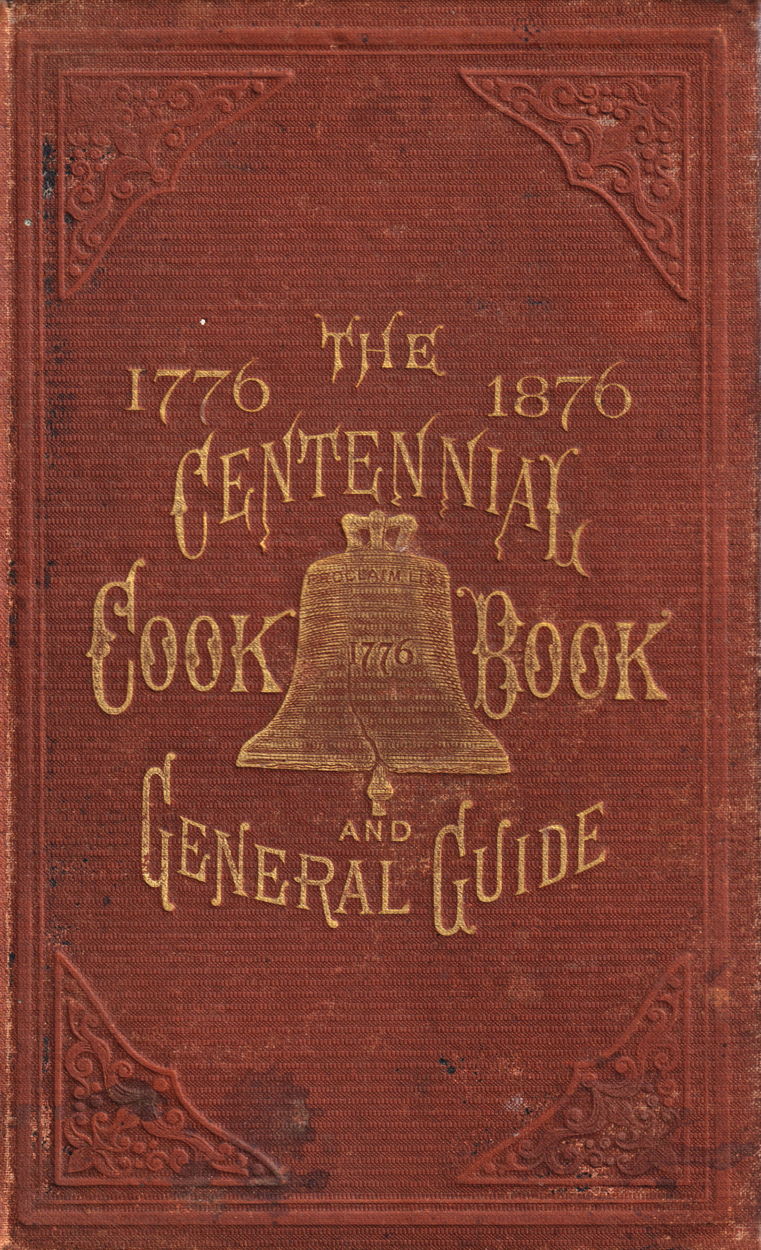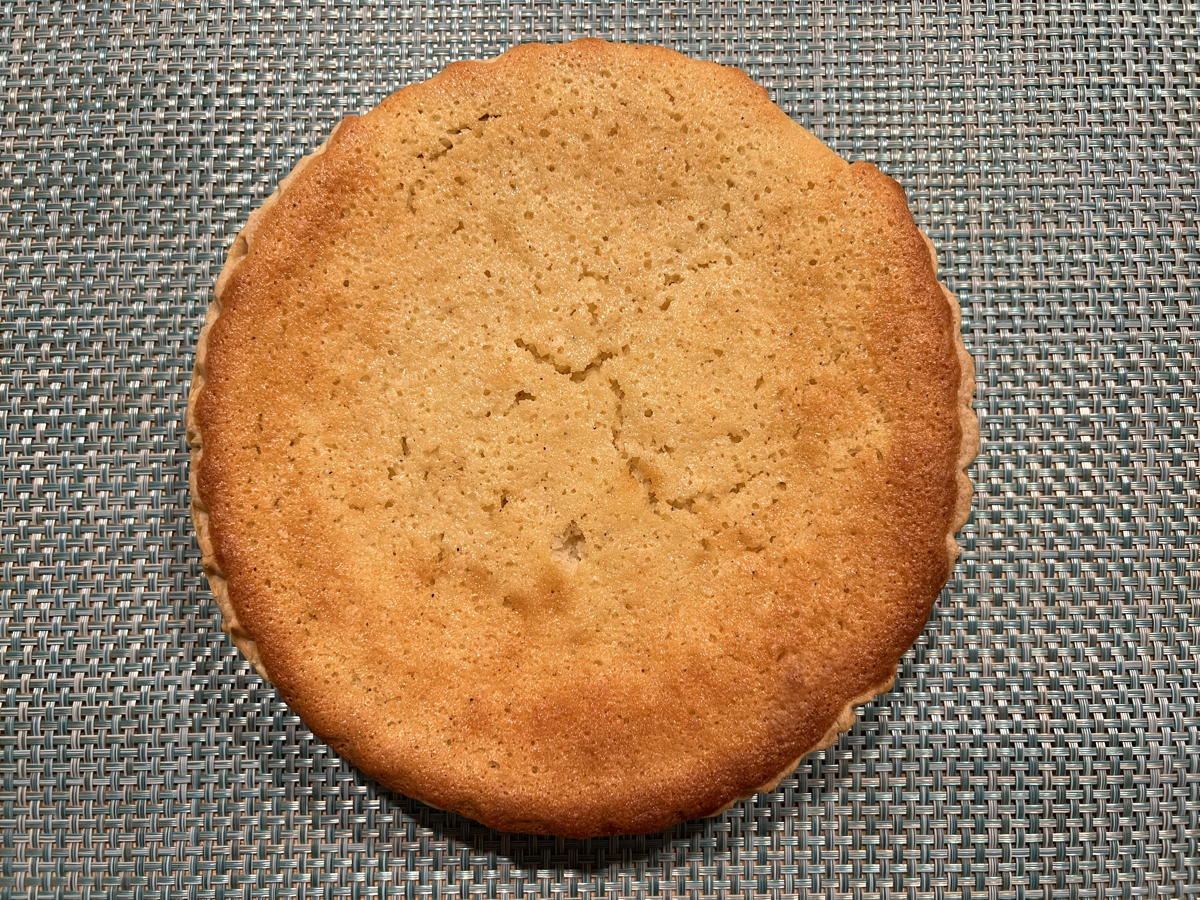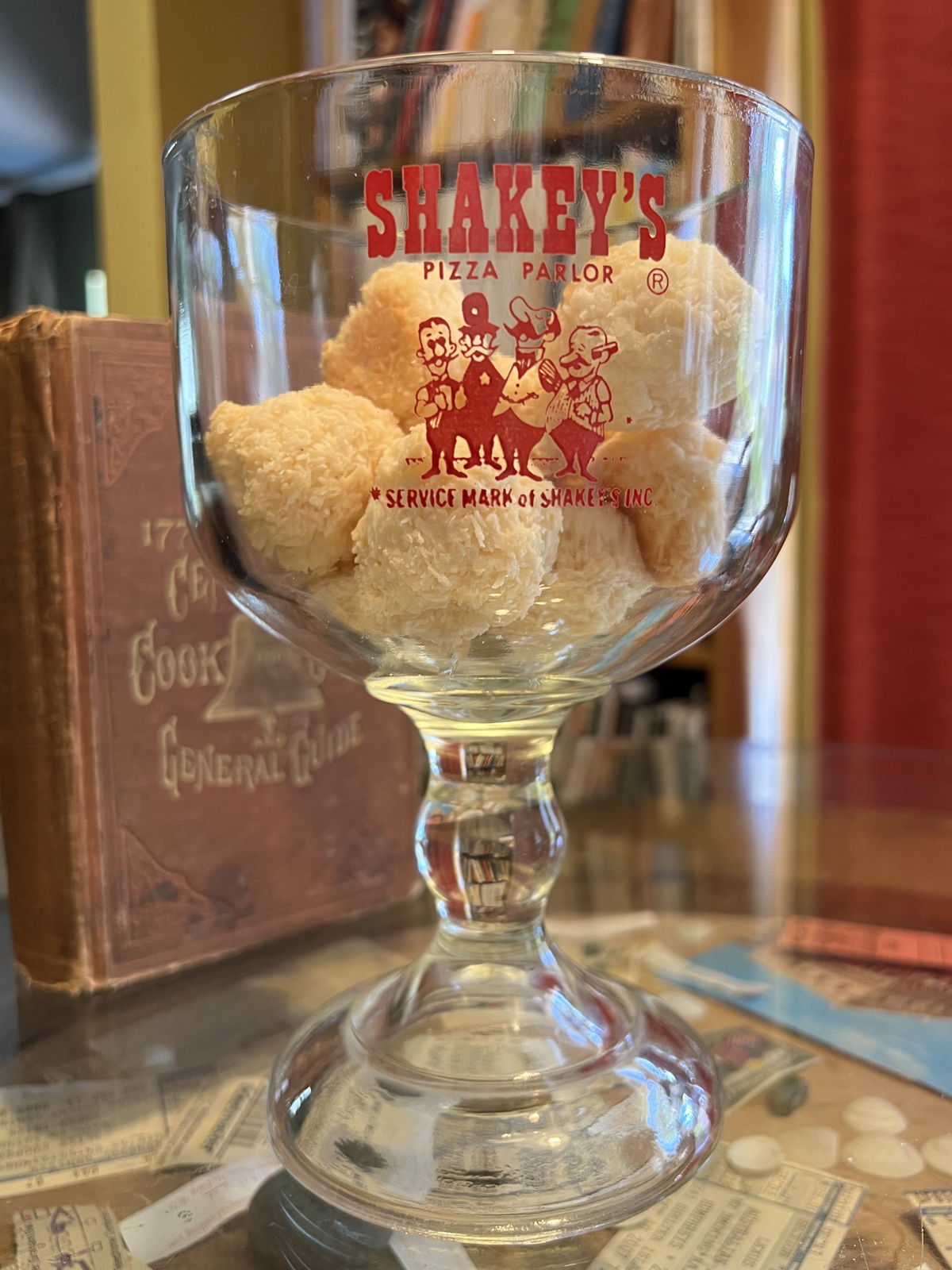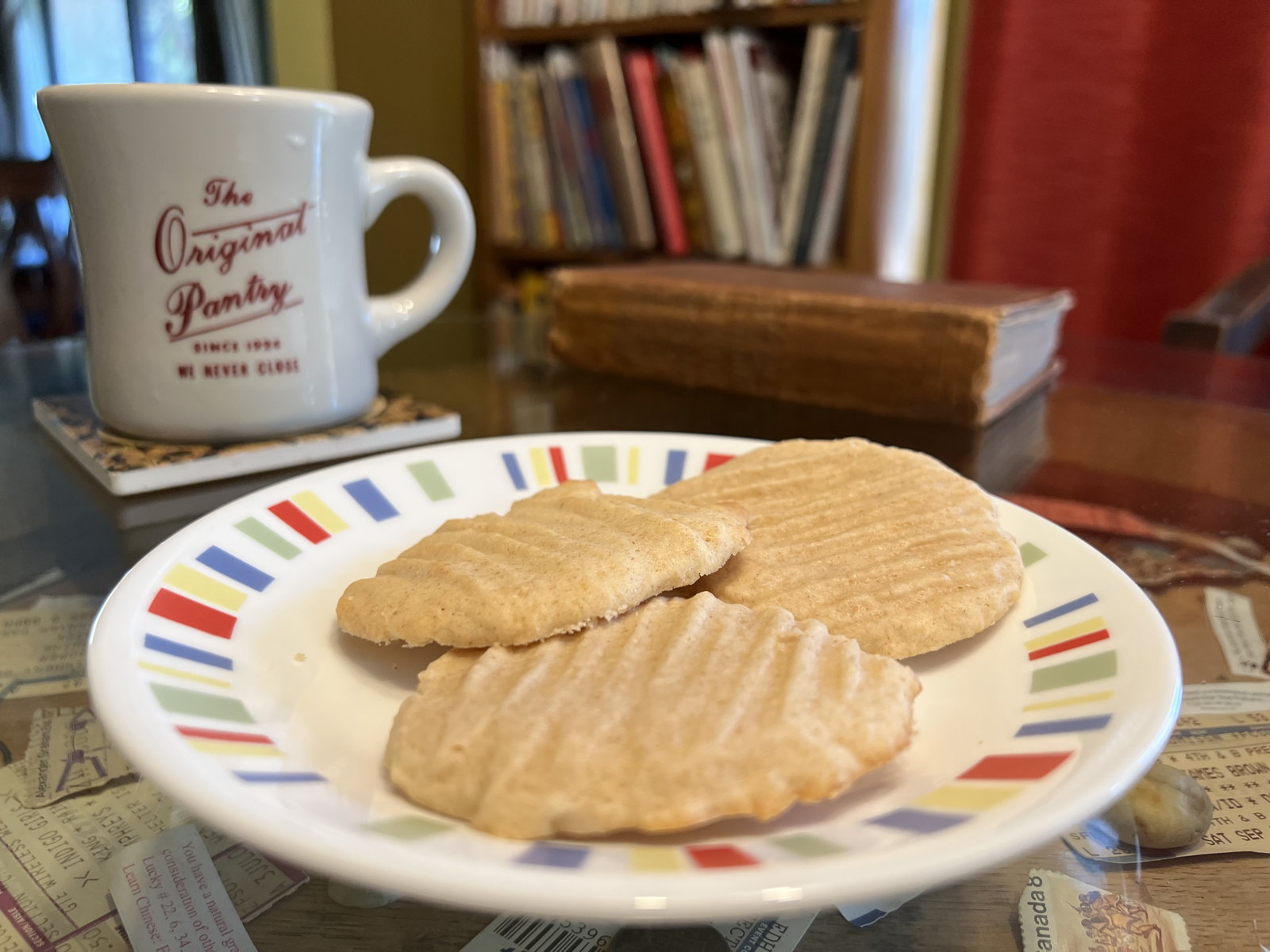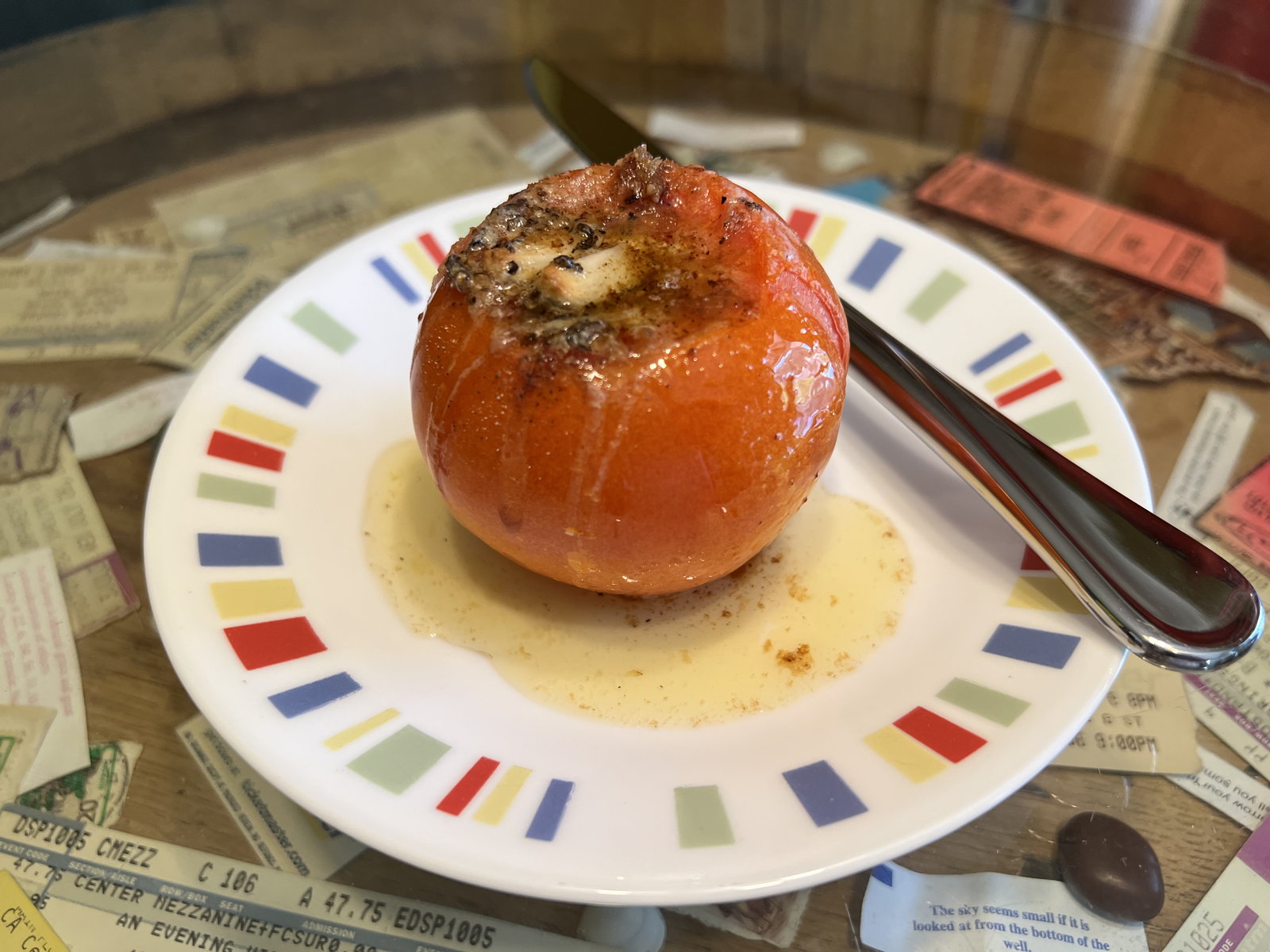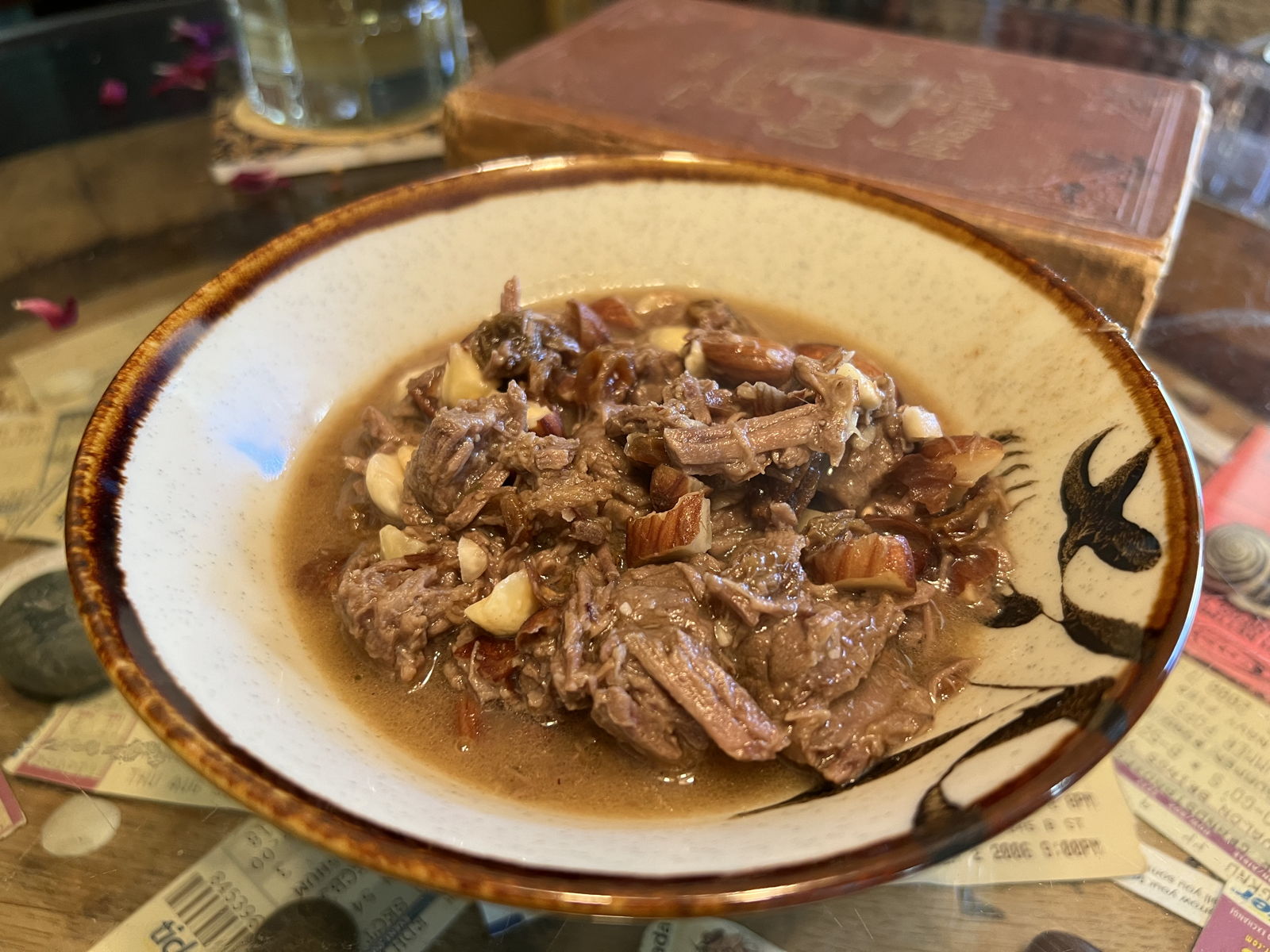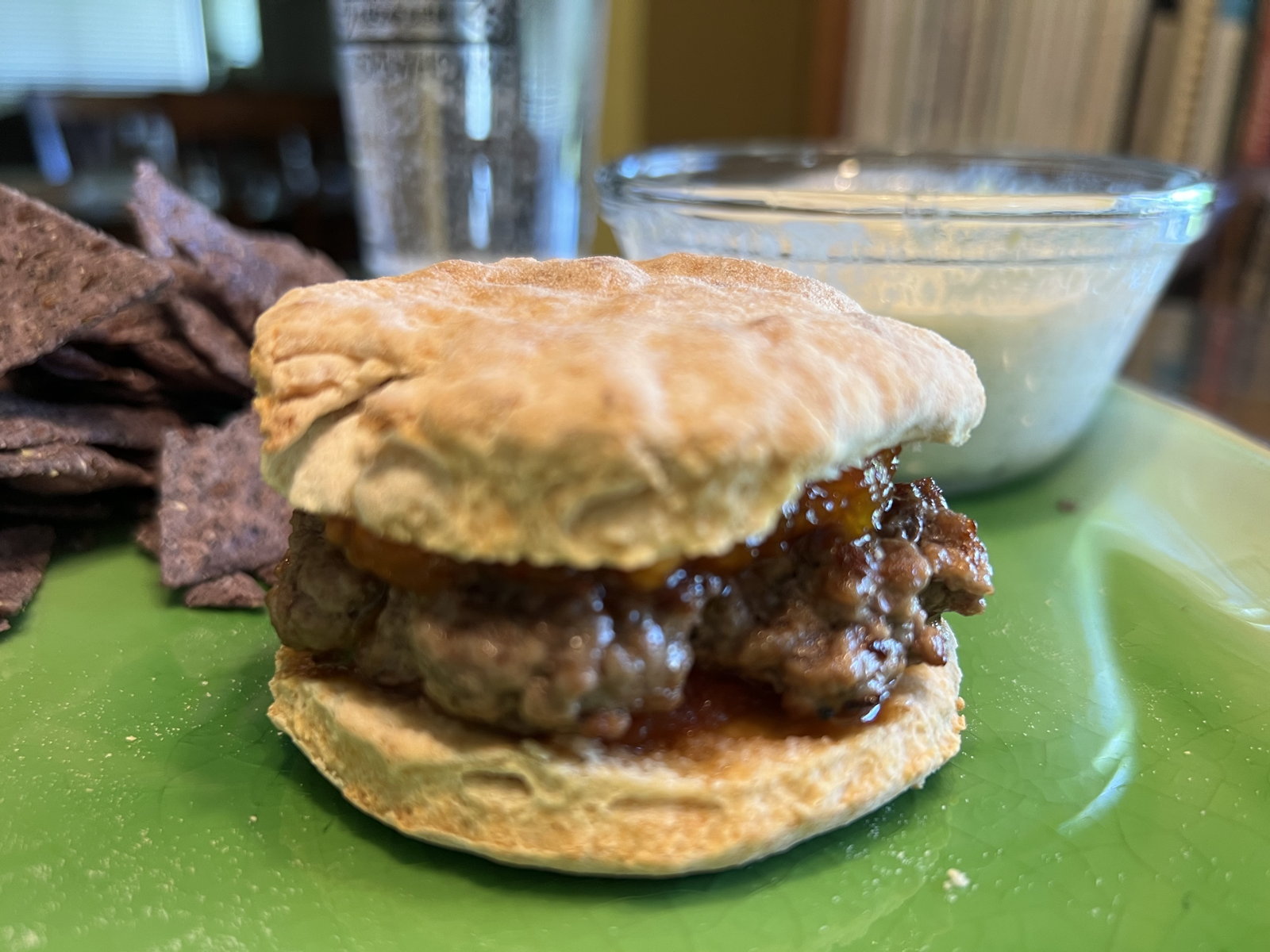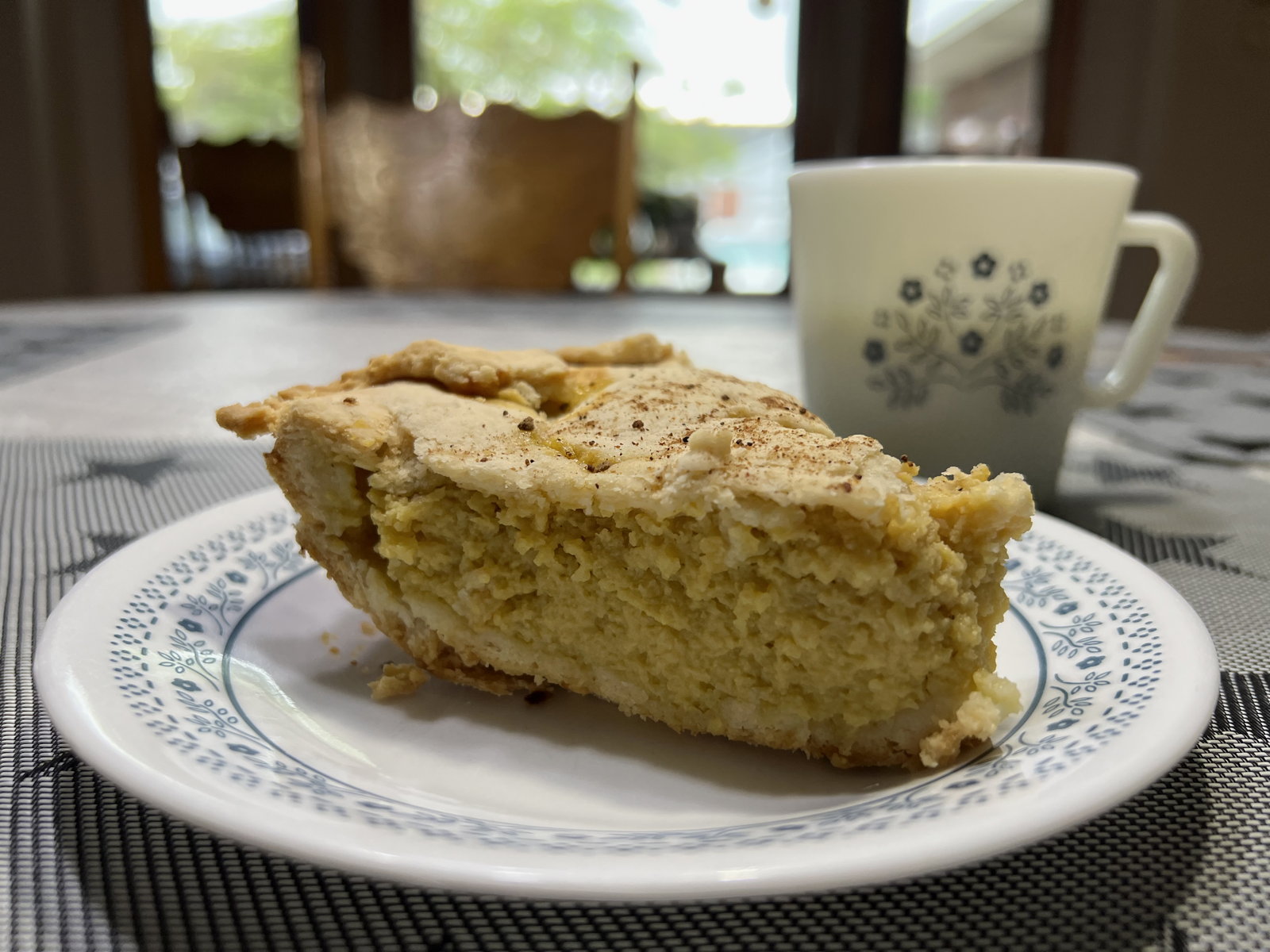A Centennial Meal for the Sestercentennial
Last year, I provided recipes from cookbooks that celebrated the bicentennial of the signing of the Declaration of Independence. This year, I’m going back to 1876 for some great—and some merely good—recipes to help celebrate Independence Day. As we near the Sestercentennial in 2026, it’s interesting to look back on our shared culinary history during previous celebrations.
One of the benefits of 150-year-old cookbooks is that this year, all of the books I’m referencing except one are available for download. The only one that isn’t available, I’ve scanned in myself. So you can download the Rumford Company’s ca. 1877 Horsford Cook-Book (PDF File, 4.7 MB) now, too.
These are books that either directly celebrated the Centennial or advertised awards for taking part in other celebrations. There don’t seem to be that many. Some may have been lost, of course, but I wonder how popular Centennial celebrations were in 1876. It was barely a decade after the Civil War ended (1865) and only six years after the last Confederate state was readmitted to the Union. Ulysses S. Grant—General Grant in the war—had just finished his second term.
Clearly, not everyone was into the spirit of ’76. The Ladies of Plymouth Church in Des Moines, Iowa came out with a cookbook that they titled, literally, “76.” (with quotes). Despite its title it does not mention the Centennial at all. At the end of its introduction it quotes Jefferson:
“May you live long and prosper.”
But that turns out to be, not the founder, but an actor famous for playing Rip van Winkle. Whether Leonard Nimoy got his variation of this randomly, via Joseph Jefferson, or via Harry S. Truman, who apparently also appropriated it, is not recorded in the historical record.
The Ladies of Plymouth were part of the temperance movement. They ended their introduction with:
The ladies who have compiled this manual have thought it not best to include alcoholic condiments, believing it better to lack a certain piquancy in a few articles of food, than to bring to the home table anything which may so easily work mischief.
Which may or may not have played into their ignoring the Centennial. It’s hard to tell how serious they were. One of the recipes, for “White Cake—Marbled” does in fact call for alcohol, and several of the helpful hints, for cleaning and for glue, also call for alcohol, which means that at the table or not they did expect you to keep alcohol in the home.
I have found two explicitly Centennial cookbooks. I have a copy of Mrs. Ella E. Myers’s Centennial Cook Book and General Guide, which is where most of these recipes came from, and I’ve also downloaded The Centennial Buckeye Cook Book. Those are the only ones I know about, but it’s likely that more exist.
There were promotional cookbooks, too. Most of them reference the Philadelphia Centennial Exposition, if they won any awards at the Expo.1 My copy of The Horsford Cook-Book (PDF File, 4.7 MB), from Rumford Chemical Works, is probably from between 1876 and 1879; my guess is 1877. The most recent award listed in the pamphlet is their “Centennial Award” from the “Philadelphia Centennial Exhibition”.
Not only will I be providing recipes from the Horsford book, I’m also providing a downloadable PDF (PDF File, 4.7 MB)! This is a very nice collection of recipes, and I strongly recommend you at least try the Irish potato pie. While it’s reminiscent of the more standard sweet potato pie, it is also very different. I suspect that even people who think sweet potato pie is too heavy will enjoy white potato pie.
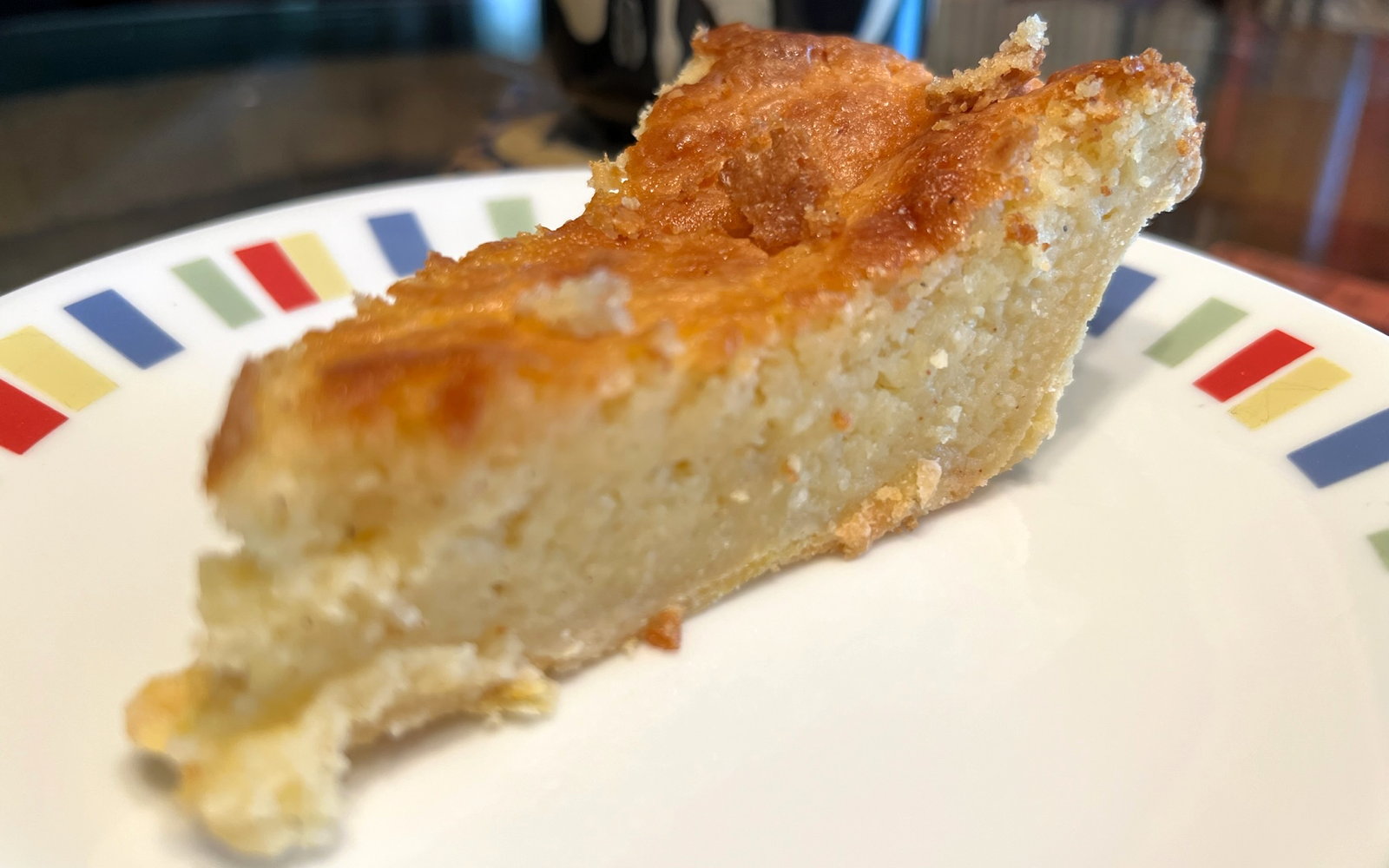
Mashed Potato Pie
Servings: 12
Preparation Time: 2 hours
The Horsford Cook-Book (PDF File, 4.7 MB)
Ingredients
- 13.5 oz mashed potato
- 6.5 oz butter
- 1-⅔ cup sugar
- 5 eggs, separated
- 1 lemon’s juice and zest
- 1 tsp nutmeg
- 1 tsp mace
- 1 unbaked 9-inch pie shell
Steps
- Rice the mashed potato through a colander or potato ricer.
- Stir the lemon juice into the mashed potato.
- Cream the butter and sugar together.
- Mix in the yolks one at a time.
- Mix in the lemon zest, nutmeg, and mace.
- Beat the mashed potato in slowly until light.
- Beat the egg whites to soft peaks and fold into the filling.
- Pour into the pie shell.
- Bake at 400° for 10 minutes.
- Reduce heat to 325° and continue baking until golden on top, about an hour.
The filling is much lighter than sweet potato filling, with a faint taste of actual potatoes. I like it a lot, and it has gotten rave reviews at both of the gatherings I’ve brought it to so far. Because I was traveling when I made this, I used a premade pie crust. If you want to go full 1876, the pie crust from the Horsford cookbook is lower down with the apple custard pie.
Some “centennial” books aren’t from the national Centennial, and some aren’t from any centennial. I’ll be providing a copy later of L.E. Brown & Co.’s New Centennial Cook Book. The “Centennial” in the title doesn’t appear to be the American Centennial, but rather their Centennial line of “Cake and Baking Pans”. The pamphlet isn’t listed in their advertising until 1881.
And of course besides product lines named after the national or possibly state centennials some books with 1876 dates are not Centennial editions but rather printings that just happened to coincide with the Centennial. This is especially true of the apparently popular “household help” books, which often went through many printings. You’ll find nearly identical versions in printings for previous years and subsequent years, none of them referencing the Centennial.2
Almanacs usually came out yearly. One interesting bit of ephemera that has survived is Mrs. Winslow’s domestic receipt book for 1876. Earlier years called it an almanac, and it came out in 1876 because it came out yearly. I’ve seen copies from as early as 1868 and as late as 1879. Like most almanacs, it made no attempt to celebrate the Centennial.
Just as in 1976, even some cookbooks that did celebrate the Centennial did so only on the cover and perhaps in an introduction, while some celebrated the history of the country throughout the book. Myers’s book was the latter. While she emphasized the amount and quality of cookery in her book—
The space allotted to COOKERY alone embraces nearly, if not quite, one thousand receipts, being the collection of over twenty years ; and each receipt herein has been carefully analyzed and tested by me from time to time, and I can speak confidently of the correctness of each and every one of them.
—I suspect people buying it in 1876 or so bought it as much for the engravings as for the recipes. That extra content focused on the history of Philadelphia, including a lot of engravings. It is filled with…
…engravings of all the “old landmarks” in Philadelphia—Independence Hall, in 1776 and 1876; the oldest churches; the house in which the “Declaration of Independence” was written; the house where the first American flag was made; all the present public buildings, institutions, cemeteries, &c.; scenes in Fairmount Park, concluding with engravings of all the Centennial Exposition Buildings.
It was meant to be handed down from generation to generation,
…embracing a history of Philadelphia from 1609 to the present time; with matters of interest in connection with “Our Centennial.” This part is embellished with numerous fine engravings, intended to describe more minutely the progress of our city since the landing of Penn; and to give to each purchaser of this book a little souvenir of our nation’s “Centennial Birthday;” something that may be retained by future posterity as a memento of the grand celebration in this “Centennial Year, 1876.”
Seriously, I recommend that you browse through her book; this is a hard act to follow for any 2026 cookbooks!
The Buckeye book doesn’t go nearly as far, but it does have two pages of recipes from then-current state governors. Governor Safford of Arizona sent in a recipe for Enchiladas.
Any one who has ever been in a Spanish speaking country will recognize this as one of the national dishes, as much as the pumpkin pie is a New England specialty.
We definitely have it a lot easier than cooks in 1876. Consider how to prep your sugar for a cake:
Loaf Sugar should be well pounded, and then sifted through a fine sieve.—Mrs. Elle E. Myers, The Centennial Cook Book and General Guide, p. 22
It appears that sugar was generally purchased in one form and then manipulated to produce granulated, finely granulated, and even powdered sugar by the home baker. One of the recipes I made from this book were the Cocoa-Nut Cakes.
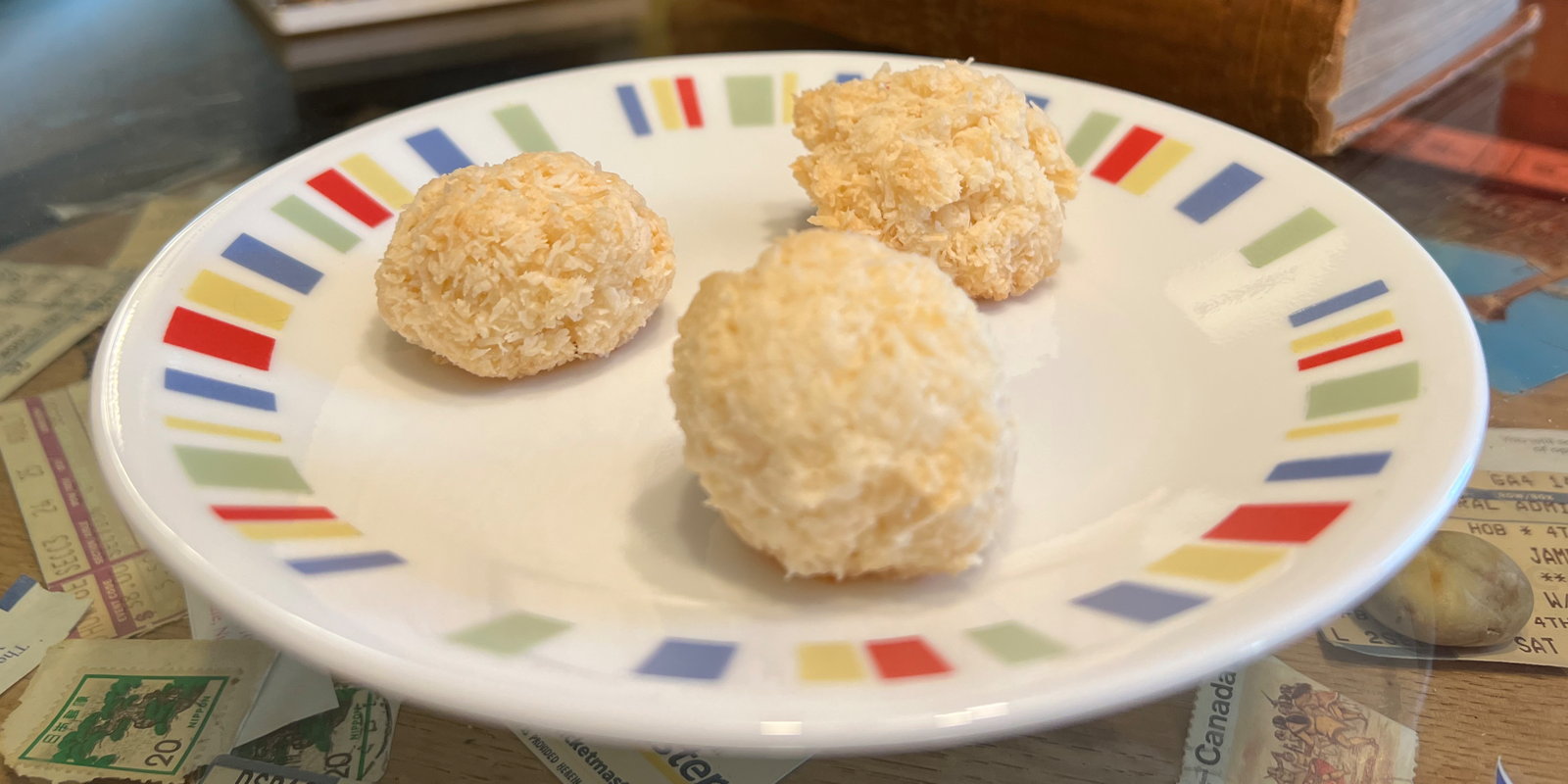
Cocoa-Nut Cakes
Servings: 12
Preparation Time: 1 hour
Mrs. Ella E. Myers
The Centennial Cook Book and General Guide (Internet Archive)
Ingredients
- 4 oz dried, ground coconut
- 1 tsp coconut or salad oil
- 2 ounces powdered sugar
- ⅛ tsp salt
- 1 egg white
Steps
- Combine the coconut with the oil and mix well.
- Stir in the sugar and salt.
- Beat the egg white to soft peaks.
- Fold in the coconut mixture.
- Drop by rounded tablespoons, rolling into a ball, on a sheet covered in parchment paper.
- Bake at 250° for 30-45 minutes.
Here’s how the recipe appeared in the original:
Cocoa-Nut Cakes.
Grate the nut (scraping off the rind) very fine, and add half its weight in finely pounded white sugar; mix them well together with white of egg, and drop on wafer paper in small rough knobs about the size of a walnut, and bake in a slack oven. Excellent for dessert.
Fortunately, today you don’t have to “Grate the nut (scraping off the rind) very fine” or pound the sugar. I used bagged, dry, shredded coconut and powdered sugar, both easily available at the grocery store!
Vanilla was only just becoming popular. J. W. Colton highlighted their own Colton’s Extract of Rose in the Centennial Cake in the J. W. Colton Centennial Cook Book. And Mrs. Winslow’s advised flavoring “with either orange-flower water or vanilla” as the flavoring for their Rock Cream—it sounds pretty good, a bit of sweetened rice covered in an uncooked meringue-whipped cream mixture “giving it the form of a rock of snow”, a phrase that itself has a different meaning nowadays.
I’m not a food historian. I don’t generally collect really old cookbooks because I try to only buy cookbooks I’m going to use. Nineteenth century cookbooks are very different from modern cookbooks in ways that can be frustrating. This is especially true of community cookbooks, where each recipe can be in a different style. The Centennial Cook Book and General Guide is a very different book in that respect. It’s the vision of one person.
Probably because of that, there are kinds of recipes that for the most part aren’t represented at all in her book, and other recipes that are but not by recognizable names. Cookies, for example. The “Almond Biscuits” look vaguely cookie-like until you start reading the instructions: with beaten egg whites they’re going to rise. Beaten egg whites was one way to make light biscuits and cakes before baking powder.
There is all of one recipe, in fact, that calls for baking powder, White Mountain Cake. The words “cookie” and “cooky” don’t appear at all, as far as I can tell. There are some ginger snaps, and some sugar drops—which are really cookies, I think—but this is not a sweets-heavy book.
The Buckeye book, on the other hand, is filled with cookies. Colton’s and Horsford have one cookie recipe each. Duryeas (see below) not only doesn’t appear to have a recipe named cookie, none of its cakes look like cookies either.
I’ve started with a dessert and a nice sweet snack for our Independence Day potluck, but we need a main dish. I honestly had no idea how Myers’s “Beef Stewed with Raisins” was going to turn out. I had the sense it was either going to be amazing or amazingly horrible. Fortunately, it turned out to be the former. One reason is a new-to-me ingredient called “browned flour”. It’s not exactly a common ingredient. In all her “1000 receipts” only two call for browned flour, this beef stew and a gizzard gravy.3
Since every ingredient in this recipe except the “good beef tea” and the browned flour call for specific amounts, I guessed that the flour was for making a light gravy and that the amount depended on the amount of liquid left in the stew after two hours of simmering. I chose three tablespoons of flour because I had about three cups of liquid remaining. Gravy normally calls for 1-½ tablespoons flour for every cup, and I didn’t want this to be as thick as gravy.
I browned normal flour in a dry pan, stirring constantly over medium heat for about seven minutes until it was a rich golden brown. Since the recipe also calls for “four ounces of butter” and I’ve seen Glen Powell rave about the wonders of flour mixed with butter for thickening several times I chose to mash the browned flour with half of the butter.
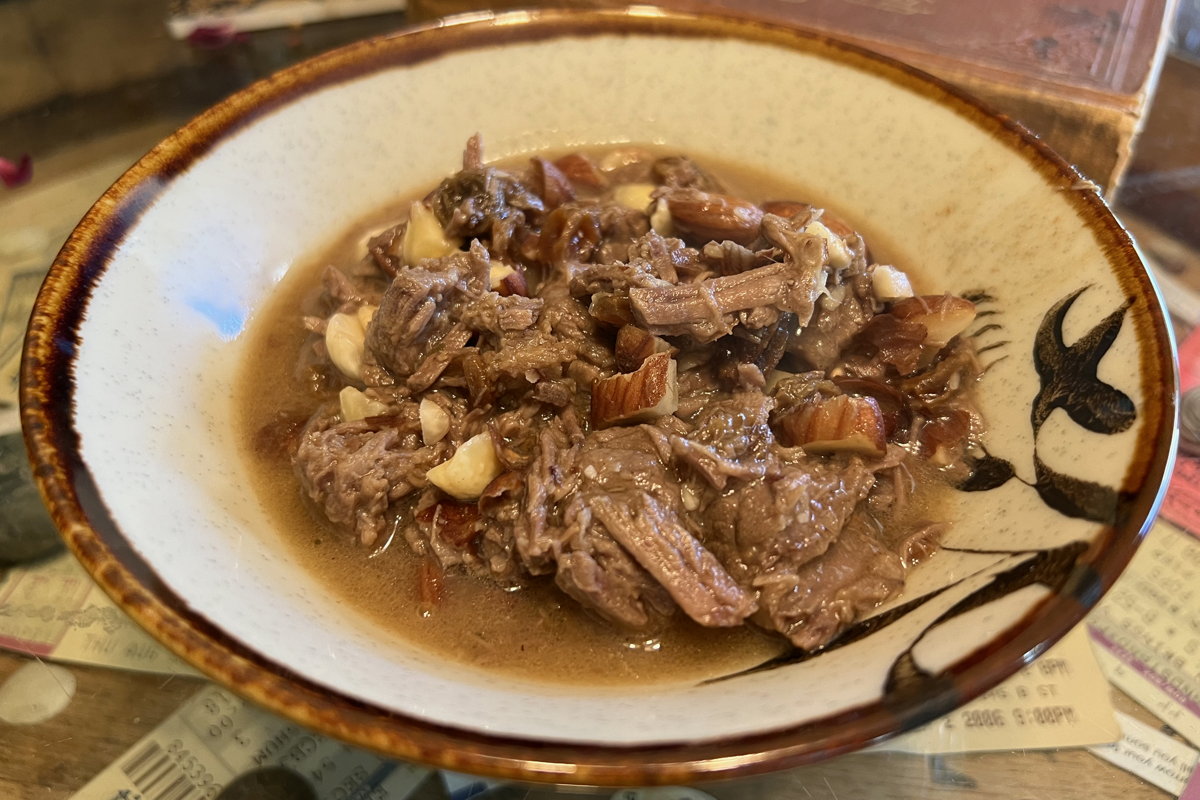
Beef Stewed with Raisins
Servings: 6
Preparation Time: 2 hours, 30 minutes
Mrs. Ella E. Myers
The Centennial Cook Book and General Guide (Internet Archive)
Ingredients
- 2 lbs stewing beef, such as chuck roast
- 2 tbsp lard
- 4 cups beef stock
- 8 oz golden raisins
- 4 oz butter
- 3 tbsp flour (about one tbsp per cup of remaining liquid)
- 4 oz unsalted almonds, toasted, chopped
- ⅓ tsp nutmeg
- salt as needed
Steps
- Bring the stock to a boil.
- Cut the beef into 1-½-inch or so cubes.
- Brown the beef in lard.
- Simmer the beef in the stock, over very low heat, for two hours.
- Meanwhile, brown the flour by stirring it constantly in a hot dry pan for 5-10 minutes until it is golden brown.
- Mix the flour with half of the butter.
- When the beef is done, shred it with two forks.
- Return the beef to the stock, if removed, and add the remaining butter, raisins, and almonds.
- Add the nutmeg, and season with salt as necessary.
- Add the browned flour butter in small chunks.
- Return to a simmer and simmer until thick, about five to ten minutes.
That browned flour butter was pretty good all on its own. It makes me wonder if the flour in the maple wheat ice cream from Frigidaire, 1928 would be better off browned first before turning it into a paste.
Even with every ingredient uncharacteristically calling for defined amounts, this recipe still required a lot of interpretation. Here’s the original for comparison, in case you would interpret it differently:
Beef Stewed with Raisins.
Boil two pounds of meat in a little good beef tea, cut the meat in pieces, then add half a pound of raisins, four ounces of butter, some browned flour, a quarter of a pound of sweet almonds cut in pieces, and allow all to stew some time.
You’ll notice that nowhere in it does it mention nutmeg. If you’re more familiar with antique recipes you’ll also notice, however, that nowhere in it does it mention salt. It is of course entirely possible that the meat, the butter, and the “beef tea”4 already have salt in them, but it will still have to be adjusted. That this isn’t mentioned almost certainly means that the recipe writer is assuming you’ll season it appropriately at the time you make it. Because of that, I also assumed that other seasonings might be appropriate, and after watching too many Townsends videos, nutmeg seemed a likely option. I wouldn’t be surprised if a cook of the era wouldn’t add some pepper also or instead.
And for further comparison, and why I say this is uncharacteristically specific, here’s the recipe immediately preceding the Beef Stewed with Raisins:
Beef Stewed with Carrots.
Take a small piece of juicy beef, cut some carrots in thin slices, add a spoonful of flour and four ounces of butter, let them stew well with the beef, put in some salt and some stock, if necessary, serve with the carrots over the beef.
It’s amazing to me that the only two ingredients in that recipe that come with specific amounts are the flour and the butter. Presumably you’re supposed to adjust the stock to the amount of flour, but just as presumably you’re going to adjust the definition of “small” and “some” to the number of people you’re making the recipe for.
The beef stewed with raisins, however, was a real treat. It could be served with the meat, raisins, and nuts separate from the gravy, much like pulled pork. Or it could be served with everything together, alone, or on rice, bread, or pasta. Mixed with rice or pasta it would make a great casserole for the potluck board.
Either way a gravy this good screams for a baking powder biscuit. While baking powder hadn’t made a dent on Mrs. Myers, this era is the beginning of the baking powder wars. The baking powder in the Horsford cookbook is not what we’re familiar with. The “acid” Horsford used was “Acid Phosphate of Lime” as a powder.5 According to Bitters and Bottles, “Acid Phosphate is actually a partially neutralized solution made with salts of calcium, magnesium and potassium.”
You can substitute modern ingredients exactly, either by using the same amount of cream of tartar for the acid and leaving the baking soda the same, or by combining the two amounts and using baking powder. Since the amount is almost always two teaspoons plus one teaspoon6, that means almost always a heaping tablespoon.
You might even go so far as to double the amount of cream of tartar used, depending on the recipe. Cream of tartar has a pH of 4-5, and acid phosphate a pH of 2 or so. Lower pH means higher acidity. You could also use sour milk or buttermilk to add more acid.
Horsford’s Centennial rolls are a very basic biscuit. They contain neither shortening nor egg.
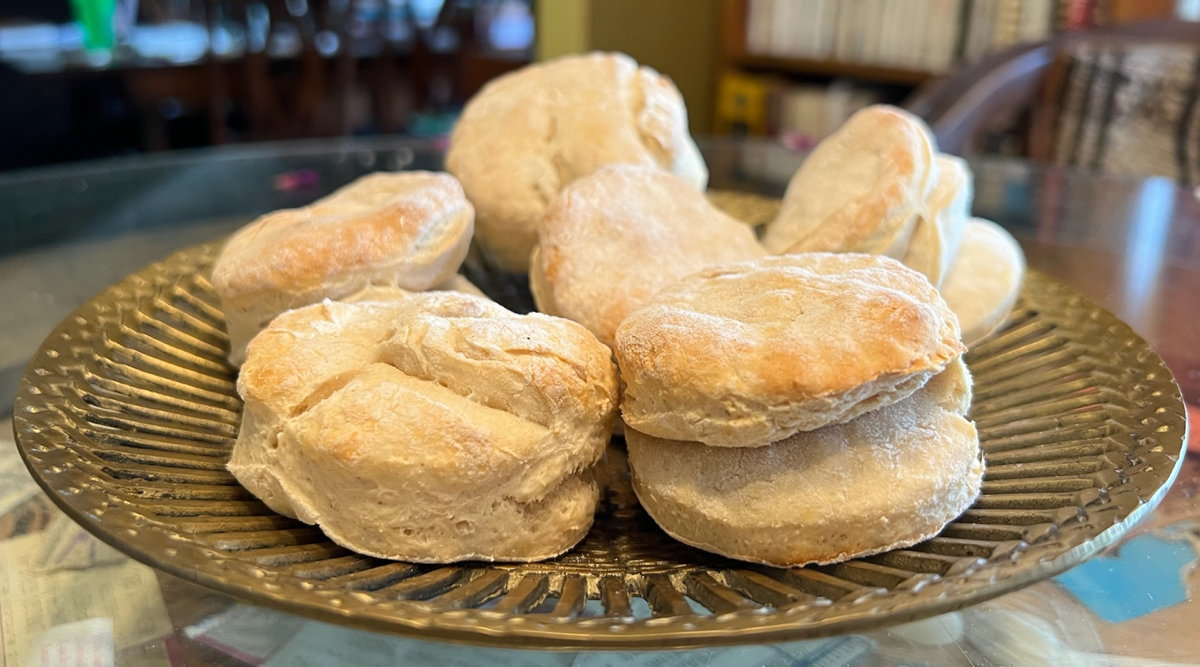
Horsford’s Centennial Biscuits
Servings: 16
Preparation Time: 40 minutes
The Horsford Cook-Book (PDF File, 4.7 MB)
Ingredients
- 4 cups sifted flour
- 1 tbsp baking powder
- ½ tsp salt
- 2 cups milk or sour milk
Steps
- Sift together baking powder, salt, and flour.
- Stir in enough milk to make a soft and easily rollable dough.
- Knead on a floured surface by folding four times, lightly flouring with each fold.
- Roll and cut into biscuits, placing on an ungreased baking sheet.
- Let sit for five to ten minutes.
- Bake for 12-15 minutes at 425°.
These are decent biscuits, despite being called rolls in the original. A much more interesting recipe from Horsford’s is their rice muffins. It’s likely that the eggs in the muffins provide additional leavening compared to the Centennial rolls.
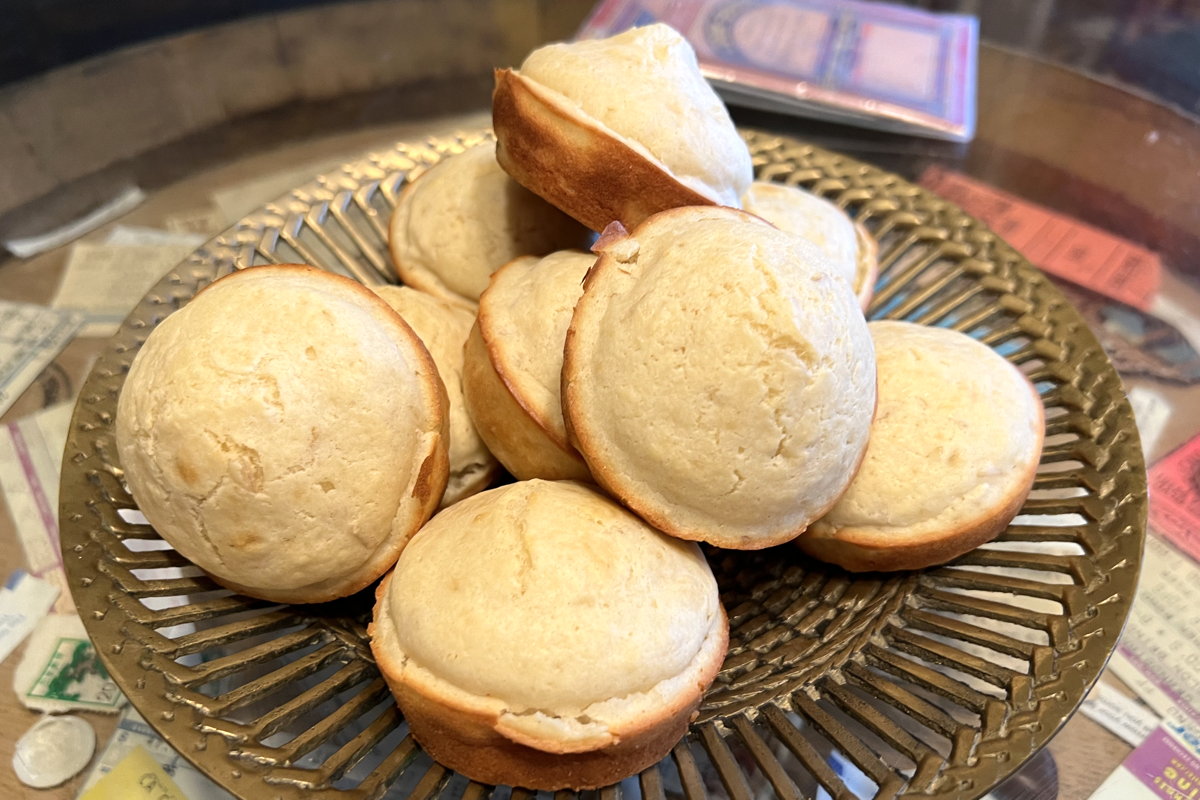
Rice Muffins
Servings: 12
Preparation Time: 40 minutes
The Horsford Cook-Book (PDF File, 4.7 MB)
Ingredients
- 2 cups sifted flour
- 1 tbsp baking powder
- ½ tsp salt
- 1 cup cold cooked rice
- two eggs
- 1 tbsp melted butter
- 1-¼ cup milk
Steps
- Mix the flour, baking powder, and salt.
- Add the rice, eggs, and butter.
- Add enough milk to make a thin batter.
- Bake 12-14 minutes at 450°.
These have an almost pancake-like texture. If you choose to serve them, I suggest accompanying them with butter or a buttery spread, and jam. They were also very good served with chili, which means they’re likely to be good with the gravy from the beef and raisins.
That makes a dessert, a bread or two, and a stew. A fascinating and wonderful side dish is the “Baked Tomatoes—American” from the Centennial Cook Book.
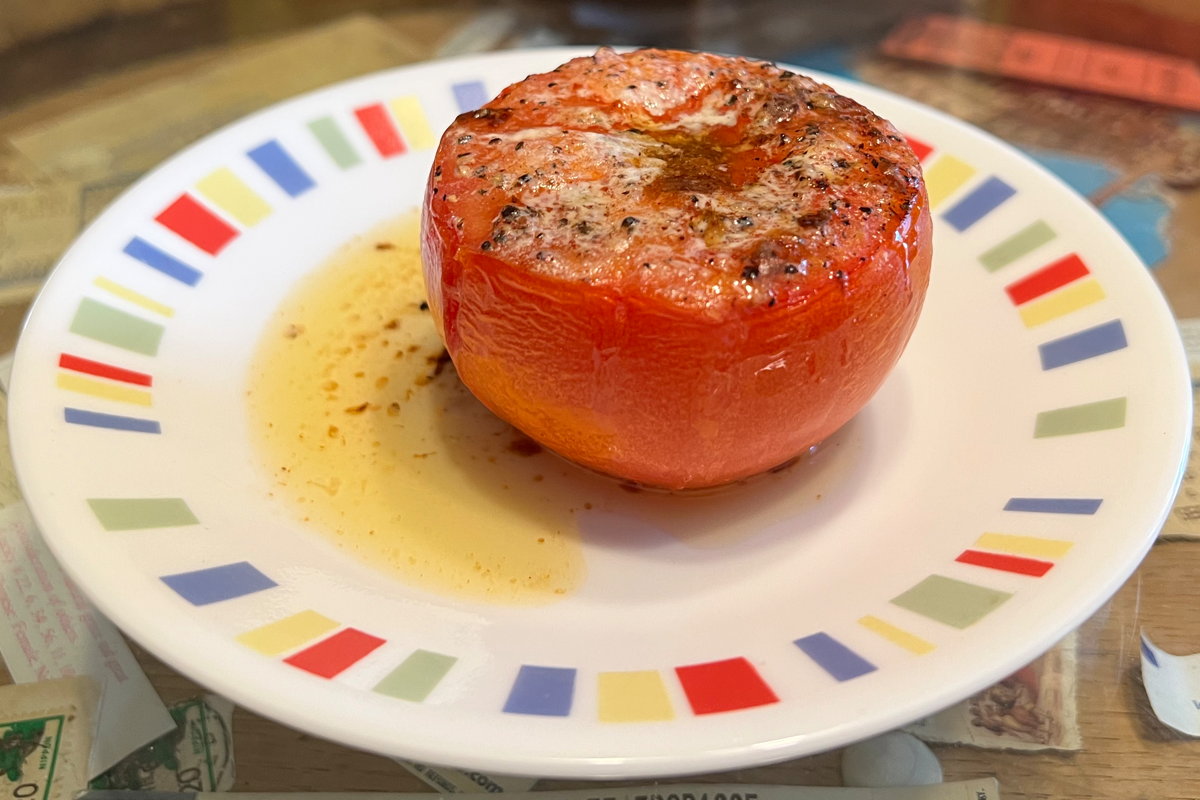
American Baked Tomatoes
Servings: 1
Preparation Time: 1 hour
Mrs. Ella E. Myers
The Centennial Cook Book and General Guide (Internet Archive)
Ingredients
- 1 medium-large tomato
- ⅛ tsp salt
- pinch of pepper
- ½ tbsp butter
Steps
- Clean one tomato per person.
- Cut stem from each, leaving a small indentation.
- Sprinkle salt and pepper into opening.
- Top with butter.
- Bake 50-60 minutes at 350° or in a covered grill.
This is extraordinarily tasty and very easy. It’s easily eaten using steak knives to slice off pieces—not because it’s tough but because it will fall apart if you try to cut it using a fork or spoon. This may be my favorite recipe from the book so far. I’ve made it several times since—it was the first recipe I tried—and I’ve changed it up by adding a garlic slice with the butter, and by making it on the grill with corn on the cob. But tomatoes baked with butter is on its own wonderful.
All summer barbecues require a coleslaw. Mrs. Hawkins’s cabbage salad from the Centennial Buckeye Cook Book is a fascinating example of an 1876 salad. She doesn’t call it coleslaw, but that’s clearly what it is, at least if I’ve interpreted it correctly. It comes across as sort of halfway between coleslaw and salad. Modern eaters may find it a little dry, so you might wish to up the vinegar depending on your own tastes.
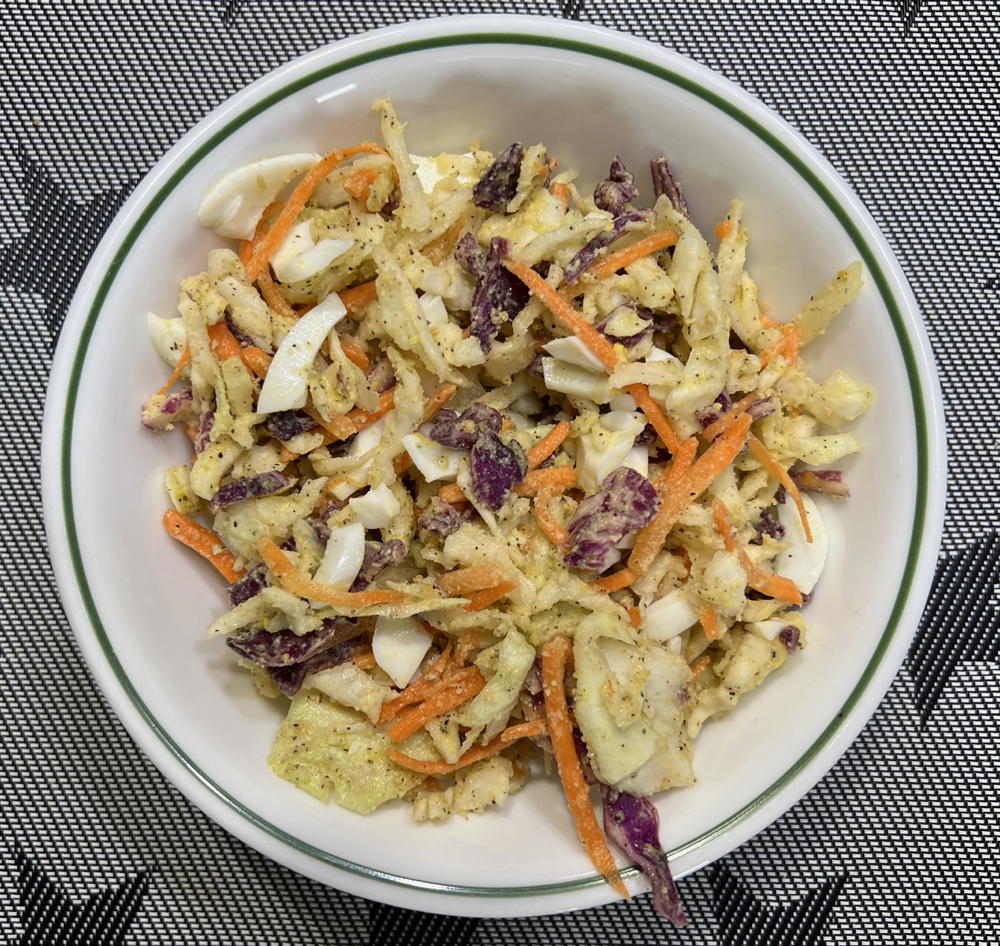
Mrs. Hawkins’s Black Pepper Slaw
Servings: 12
Preparation Time: 1 hour
Mrs. Hawkins
The Centennial Buckeye Cook Book (Internet Archive)
Ingredients
- 2 lbs shredded cabbage
- 1-2 tbsp salt
- 2 tbsp sugar
- 1 tbsp black pepper
- 1 tbsp ground mustard
- 4 hard boiled eggs, separated
- ½ cup melted butter
- ¾ cup vinegar
Steps
- Mix the cabbage, salt, sugar, pepper, and mustard.
- Mash the egg yolks smooth.
- Mix the butter and yolk thoroughly to make a creamy paste.
- Stir the yolk and then the vinegar into the cabbage.
- Slice the egg whites and toss into the salad.
- Adjust vinegar, salt, sugar, and pepper as desired.
It would be pretty good on a sandwich, too, especially one made with cornbread.
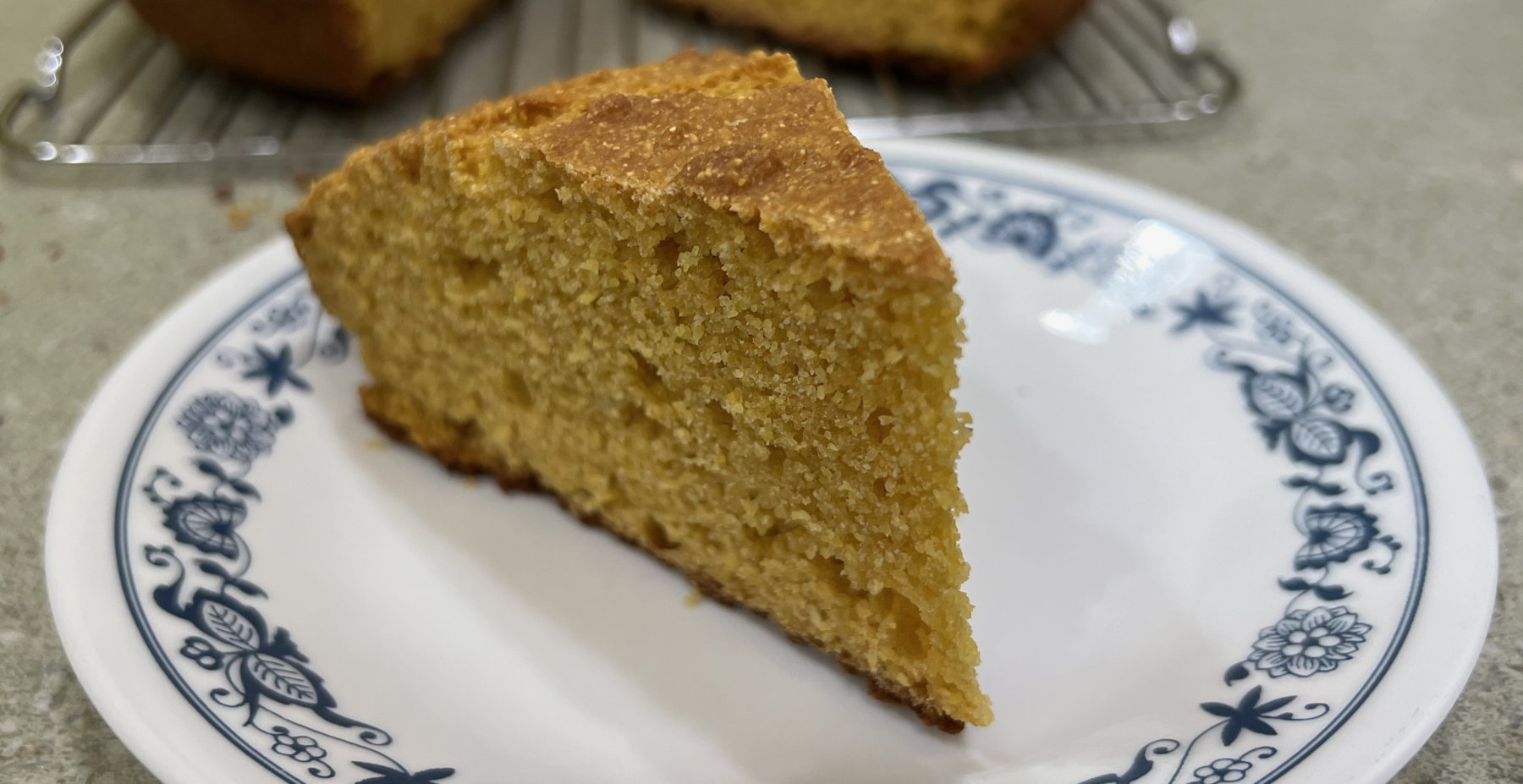
Colton Cornbread
Servings: 8
Preparation Time: 1 hour
J. W. Colton’s Choice Cooking Recipes (Science History Institute Museum & Library)
Ingredients
- 2-½ cups cornmeal
- 1-¼ cups flour
- 1 tsp soda
- ½ tsp salt
- 1 egg, separated
- 2 tbsp molasses
- 2 cups buttermilk
Steps
- Mix flour, soda, and salt.
- Add and mix cornmeal.
- Mix the egg yolk, molasses, and milk.
- Stir into dry ingredients.
- Beat the egg white to stiff peaks.
- Fold into batter.
- Bake at 375° for 30-40 minutes in a well-greased cast iron pan.
- Let cool a minute or two and remove to a rack to cool as desired.
As I’ve modified this cornbread, it’s a pretty basic cornbread by modern standards. If you want to go full 1876, look in J.W. Colton’s cookbook for the original recipe: it involves steaming the cornbread rather than baking it, which is likely to be an entirely different texture! It would also be more work and not something I’d want to do in July in Texas. It highlights a big difference between today and 1876: it was probably easier in some cases to boil bread then than it was to start up the oven, get it to the right point in the oven’s cooling process, and bake.
Part of the reason you don’t need to pound your own sugar today is the proliferation of corn starch. Corn starch is the main reason powdered sugar can be sold commercially: it keeps powdered sugar from clumping. One of the pioneers was the Duryeas Corn Starch Manufacturing Company, and one of the more versatile recipes in this collection is the omelet from Duryeas’ Valuable Recipes for Cooking. The omelets are made with cornstarch to give them a very faintly pancake texture. They were quite good made as written without any filling or added spices. But they’d be great filled with a meat sauce or with a jam or jelly. Slice them in strips and you’ve got a nice snack for the snack table, sweet or savory.
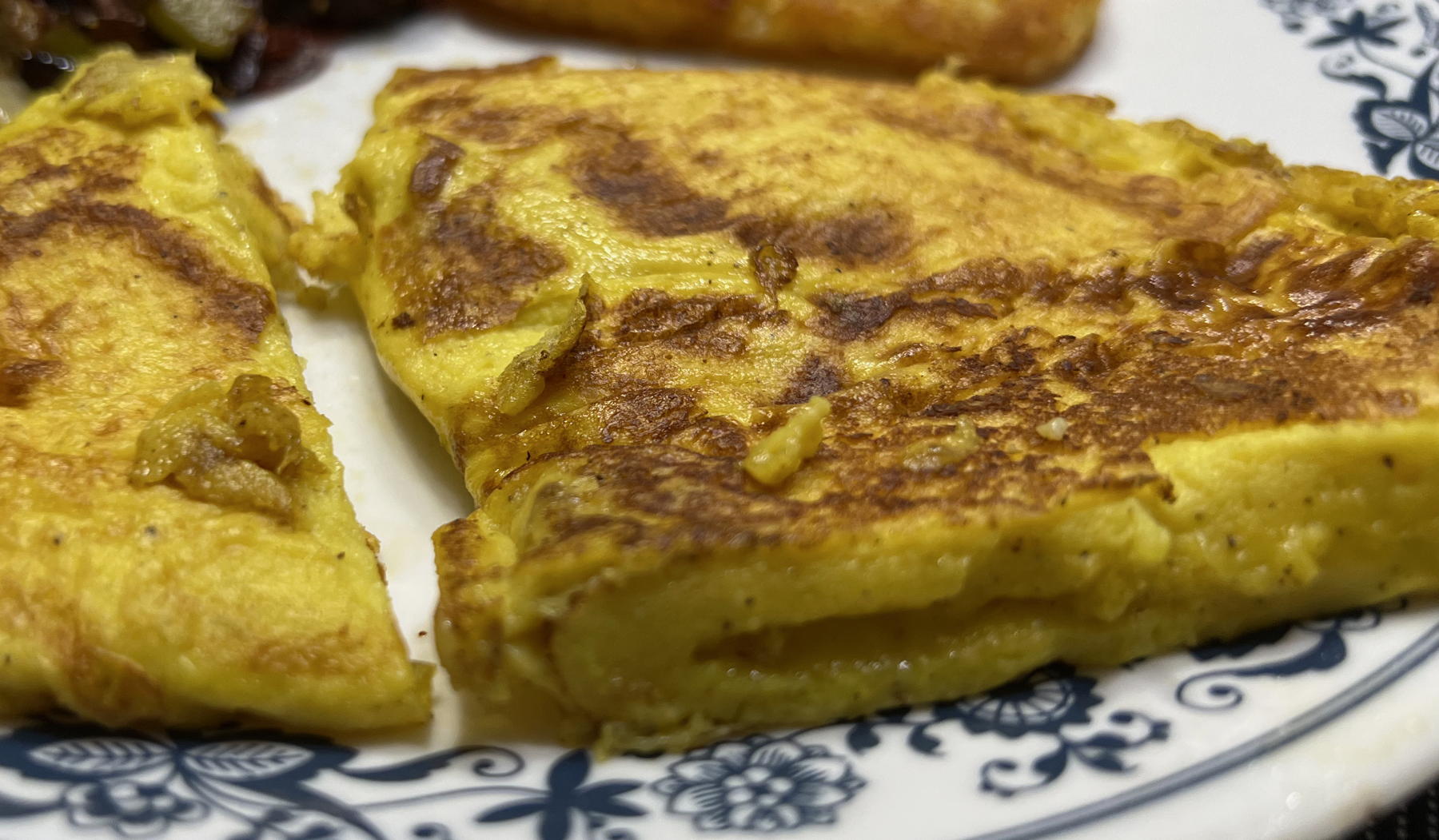
Omelet Snackers
Servings: 1
Preparation Time: 15 minutes
Duryeas’ Valuable Recipes for Cooking (Little Cookbooks)
Ingredients
- 1 egg
- 2 tsp corn starch
- ¼ cup (scant) milk
- ⅓ tsp salt
- ⅓ tsp pepper or 1 tbsp sugar
- spices as desired
- 1 tbsp butter
- filling as desired
Steps
- Beat egg(s).
- Whisk in corn starch.
- Whisk in milk until smooth.
- Whisk in salt, spices, and/or sugar.
- Fry in butter, shaking pan horizontally.
- When still wet on top, add a savory or sweet filling if desired, and then fold in half or thirds.
- Remove when still slightly wet inside.
Also for the sweet snacks table, I strongly recommend, in addition to the cocoa-nut cakes mentioned above and any possible omelet snacks, the “German Biscuits” below. I can’t really complain about calling the cocoanut candies “cakes” because even now we don’t really have a name for them. They’re that class of sweet snack we would call cookies, or balls, or just candies. These German biscuits, however, are definitely what we would call cookies. Lemon-flavored cookies, an often-neglected but always wonderful flavor for cookies.
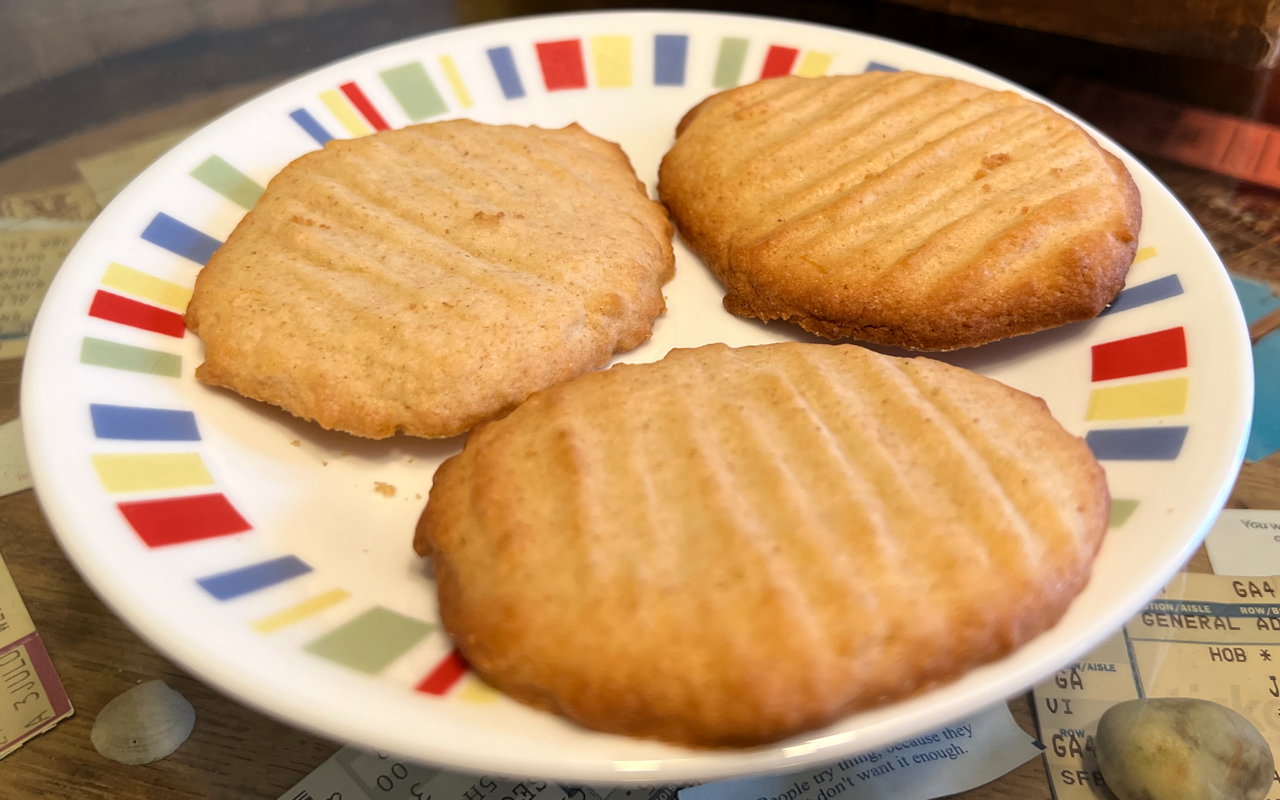
German Biscuits
Servings: 48
Preparation Time: 40 minutes
Mrs. Ella E. Myers
The Centennial Cook Book and General Guide (Internet Archive)
Ingredients
- 7 oz white flour
- 4 oz whole wheat flour
- 5 oz butter
- 7 oz sugar
- 2 eggs, well-beaten
- 4 tsp cream
- grated peel of one lemon
Steps
- Beat butter creamy.
- Mix in the sugar and lemon peel.
- Stir in the flour.
- Add the cream and eggs.
- Mix well to a light dough.
- Drop by teaspoons onto greased baking sheet and flatten with a wet fork.
- Bake at 6-8 minutes at 425° until golden.
I’ve no idea what makes these “biscuits” German.
There are some very interesting and nice recipes in these books that shouldn’t be lost. The beef with raisins, the baked tomatoes, and especially the Irish potato pie fall into that category. Another one is this Apple Custard Pie from the Horsford Cook-Book (JPEG Image, 284.1 KB). It’s made like a pumpkin pie but with apples and with a lot less sugar.
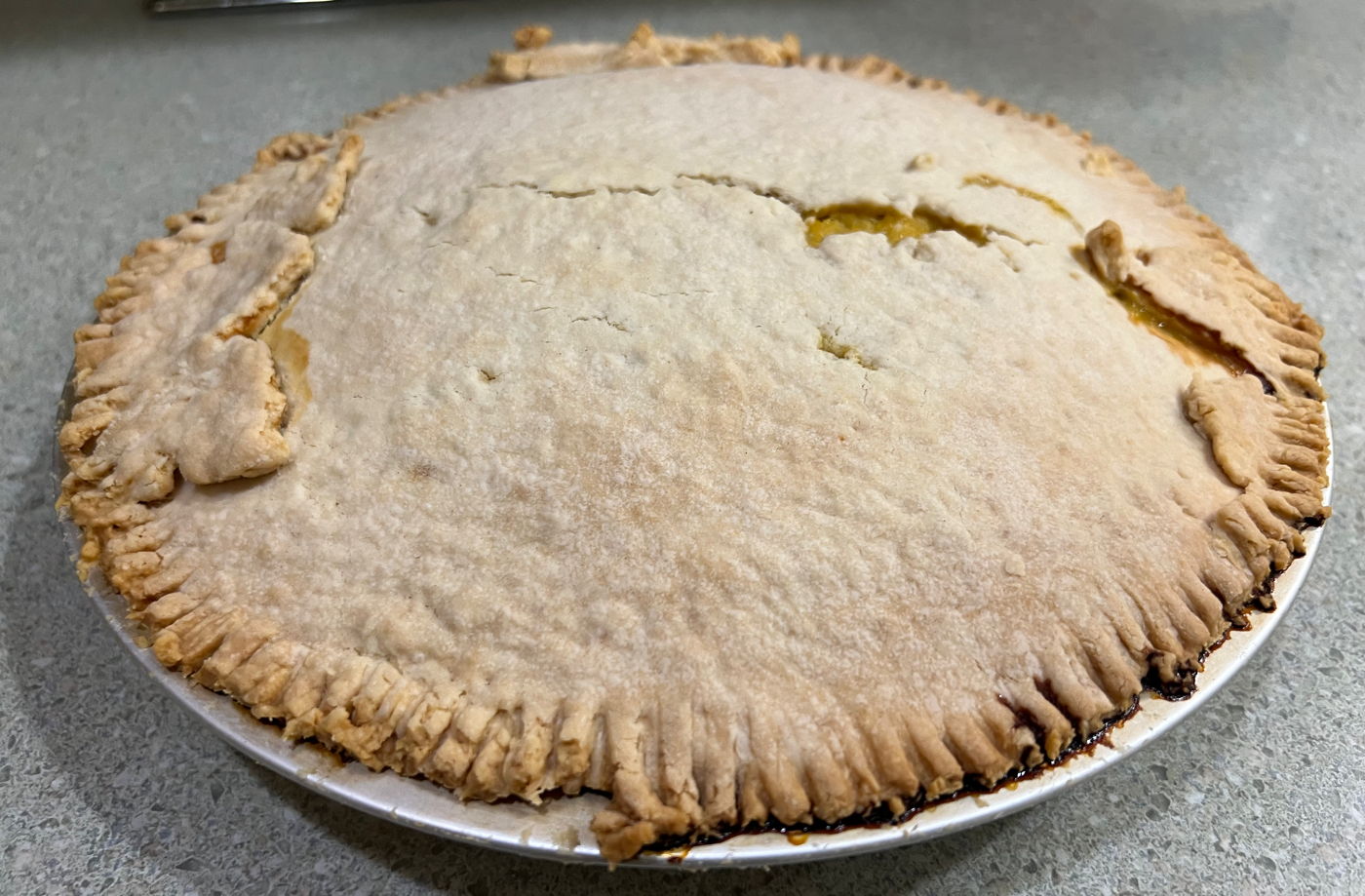
Apple Custard Pie
Servings: 8
Preparation Time: 2 hours
The Horsford Cook-Book (PDF File, 4.7 MB)
Ingredients
- 2-½ lbs Granny Smith apples
- ⅓ cup butter
- ⅓ cup sugar
- 3 eggs
- ½ tsp nutmeg
- 2 9-inch pie crusts for bottom and top
Steps
- Peel, core, and purée apples in food processor until smooth.
- Stew over medium-low heat until no water pools at bottom when stirring.
- Or, consider baking the apples whole and using a food mill to get the meat without the core and peel.
- Let cool.
- Blend the ⅓ cup butter into the apple.
- Blend the sugar into the apple.
- Blend the nutmeg into the apple.
- Beat in the eggs one at a time.
- Fill bottom crust with apple.
- Layer top crust over, and cut or poke holes for steam vents.
- Bake at 375° for 45-60 minutes.
- Cool to room temperature before serving.
I made them as the recipe says, by peeling, coring, and then puréeing the apples. But I suspect it would get a smoother texture by baking the apples whole and then pressing them through a food mill to separate out the core and peel.
This pie is not blow-you-away amazing as is the mashed potato pie. By modern standards it’s not really much of a dessert at all. But it is a hell of a breakfast. Cut it into eight slices and each slice has only two teaspoons of sugar, almost half of an egg, and a lot of apple. That’s a very respectable breakfast. Add a cup of milk or coffee and it’s a great way to start your Independence Day, a satisfying breakfast that doesn’t spoil your appetite for the main event!
Horsford, of course, wanted you to make their pie crust, using their baking powder.
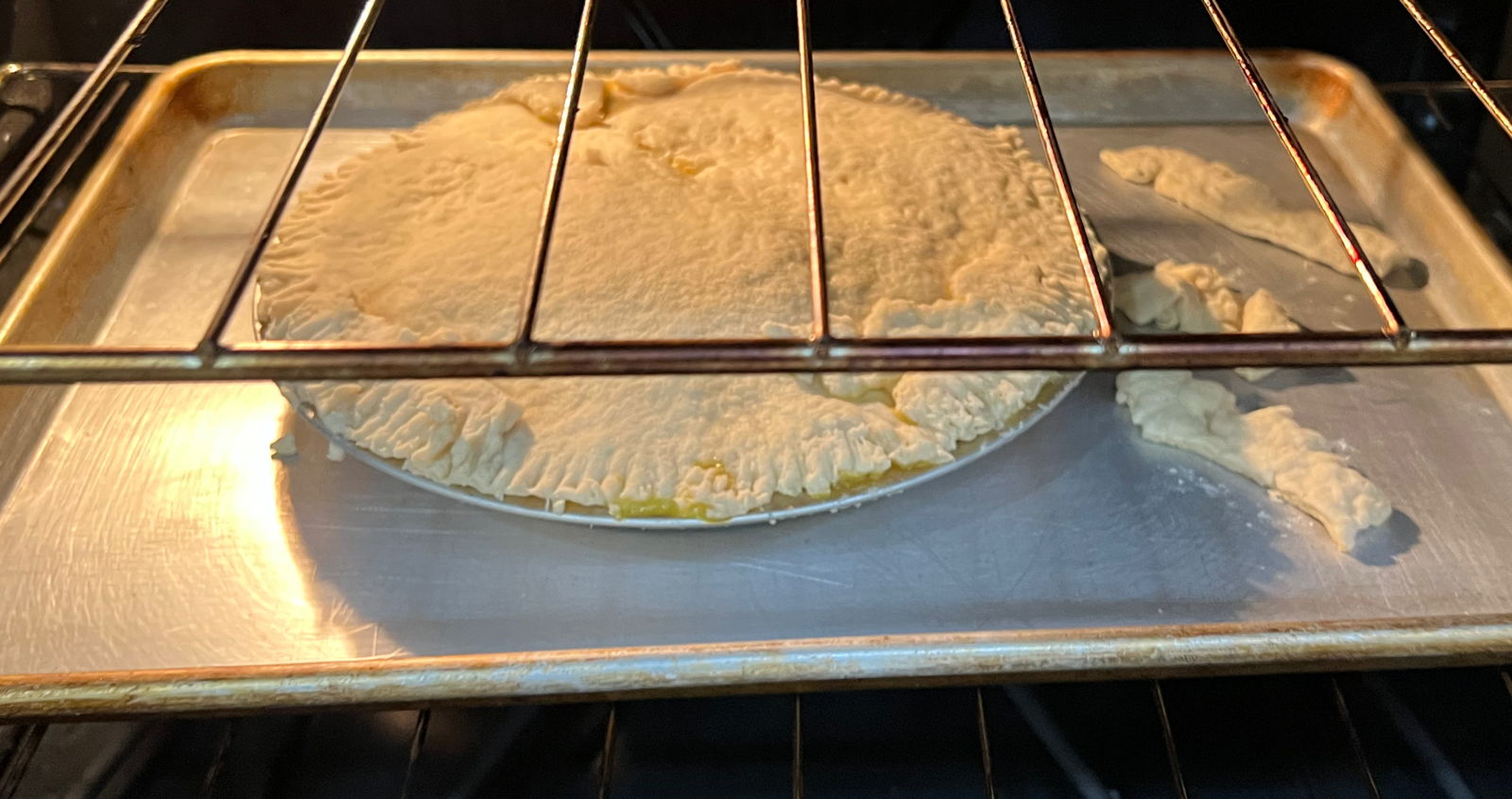
Baking powder pie crust
Servings: 8
Preparation Time: 30 minutes
The Horsford Cook-Book (PDF File, 4.7 MB)
Ingredients
- 2 cups sifted flour
- ½ tbsp baking powder
- pinch of salt
- 6-7 tbsp ice cold water
- 3 oz butter
- 3 oz very soft butter
Steps
- Combine the flour, baking powder, and salt.
- Cut in the 3 oz butter.
- Mix in enough ice water to make a rollable dough.
- Roll dough flat, brush with soft butter, fold, brush again, and fold over again. Roll and repeat. After final brush, it may be easier to fold over only once.
- Cut dough in half. Roll one into a bottom pie crust.
- Roll remaining dough into a top crust. Cut or poke holes for steam vents.
Any double crust will do, of course. And will be a lot easier than this. It was interesting making it, if a bit messy. And it was a very good, flakey crust.
It’s interesting how some things haven’t changed much except by name. The cocoanut cakes are a meringue candy or cookie. The Centennial rolls, are what we’d call biscuits. And the German biscuits we’d call cookies, although you can still see the older term in products such as McVitie’s Digestive Biscuits.
Either way, these recipes can help you and your family and friends connect with a year a century after the signing of the Declaration of Independence that had to still be a difficult one for many families ten years after a bloody civil war “testing whether that nation, or any nation so conceived and so dedicated, can long endure.”
Sometimes it feels as though there are a lot of parallels between today and the period leading up to the Civil War. Remembering the Centennial can help us remember the great principles this nation was founded on and the cost we paid to live up to them.
In response to A Bicentennial Meal for the Sestercentennial: Four community cookbooks celebrating the bicentennial. As we approach our sestercentennial in 2026, what makes a meal from 1976?
Philadelphia held an exposition in both 1876 and in 1926 (for the sesquicentennial), although the 1926 version apparently wasn’t as successful. They may be holding one in 2026 although that’s looking less likely by the minute.
↑The Centennial Buckeye Cook Book, while it is explicitly a Centennial edition, appears to be a version of an ongoing book that existed before 1876 and continued after 1876.
↑Autocorrect wants to change that to “lizard gravy”, making me feel like I’m in a Tex Avery/Chuck Jones cartoon.
↑Myers has a recipe for “Beef Tea”: “This is the simplest of all soups, being but a pound or two of shin of beef cut in small pieces, and gently stewed, with a little salt, in a pint of cold water to each pound of meat, without either vegetables or spice, for three hours. It is generally served in a basin, with toasted bread.”
I didn’t use it. I used powdered beef stock mixed with the boiling water, which is why I didn’t need to add salt. The broth was salty enough already.
↑See pages 31 and 32 of The Horsford Cook-Book (PDF File, 4.7 MB) for an ad describing what their “bread preparation” was made of.
↑A drawing of the “measure”, which provides more acid than soda, is on page 7 of The Horsford Cook-Book (PDF File, 4.7 MB).
↑
food history
- Glen & Friends Cooking: Glen Powell
- “We are food people… We grow our own gardens, we pickle, we make jam, we start with base ingredients… FOOD!”
- Horsford’s Acid Phosphate
- “A tongue tingling sensation and dry tart flavor make Acid Phosphate distinct from other acids, like citric acid. More than just diluted phosphoric acid, Acid Phosphate is actually a partially neutralized solution made with salts of calcium, magnesium and potassium.”
- Refrigerator Revolution Revisited: 1928 Frigidaire
- The 1928 manual and cookbook, Frigidaire Recipes, assumes a lot about then-modern society that could not have been assumed a few decades earlier.
- “76.” A Cook Book at Internet Archive (ebook)
- An 1876 cookbook by the Ladies of Plymouth Church in Des Moines, Iowa. “The man who can cook well and economically, and can teach the art, is a benefactor to his kind, and deserves a statue of brass, if not a canonization.”
history
- Celebrating a Century
- “1976 documentary that portrays the dramatic preparations for the 1876 Centennial Exposition in Philadelphia from the early planning stages to opening day ceremonies led by President Ulysses S. Grant and Dom Pedro, the Emperor of Brazil.”
- Review: A New Birth of Freedom: Jerry Stratton at Jerry@Goodreads
- An amazing summary of Lincoln’s interpretation of the American Founders, and his convictions about the inherent wrongness of slavery.
- Townsends
- “Live history.”
vintage cookbooks
- The Centennial Buckeye Cook Book at Internet Archive (ebook)
- “In the effort to avoid the mistakes of others, greater errors may have been committed, but the work is submitted just as it is to the generous judgment of those who consult it, with the hope that it may lessen their perplexities, and stimulate that just pride without which work is drudgery and great excellence impossible.” Compiled by the Women of the First Congregational Church, Marysville, Ohio.
- The Centennial Cook Book and General Guide: Mrs. Ella E. Meyers at Internet Archive (ebook)
- “Embracing modern cookery, in all its arts, family medicines and household remedies, farming hints and complete farriery, events of the last century… a little souvenir of our nation's Centennial Birthday; something that may be retained by future posterity as a memento of the grand celebration in this Centennial Year, 1876.”
- Duryeas’ Valuable Recipes for Cooking at Little Cookbooks (ebook)
- “Duryeas’ Improved Corn Starch, Is an entirely pure and delicate preparation, from the best varieties of Maize. It affords many delicate and nourishing dishes.”
- The Horsford Cook-Book (PDF File, 4.7 MB)
- A ca. 1876-1879 cookbook from the Rumford Chemical Works, “containing practical recipes for making superior bread, biscuit, cakes, pastry &c.”
- J. W. Colton’s Choice Cooking Recipes at Science History Institute Museum & Library (ebook)
- “J. W. Colton’s Cooking Recipes are selected with great care, and can be relied upon as tried and excellent.”
- Mrs. Winslow’s Domestic Receipt Book for 1876 at HathiTrust Digital Library
- “This Book will be issued Annually, with entirely New Receipts. By preserving them, and sewing them together, you will have in a few years, the best collection of Receipts in the country.”
More America’s Sestercentennial
- A Bicentennial Meal for the Sestercentennial
- Four community cookbooks celebrating the bicentennial. As we approach our sestercentennial in 2026, what makes a meal from 1976?
More food history
- Looking back over 1950 in vintage cooking
- While I didn’t make my goal of trying a recipe every month in the month it was meant for, following this calendar through 2023 was an interesting experience and provided some very good food.
- Refrigerator Revolution Revisited: 1928 Frigidaire
- The 1928 manual and cookbook, Frigidaire Recipes, assumes a lot about then-modern society that could not have been assumed a few decades earlier.
- Plain & Fancy in the seventies with Hiram Walker
- Enjoy a whole new world of fun, excitement and discovery in Hiram Walker Cordials, adding a personal touch to all your memorable moments and special occasions—plain or fancy!
- Finding vintage cookbook downloads
- There are several sites for finding vintage cookbooks, from general-purpose online archives to special collections at universities. Here are a few of my favorites.
- A golden harvest of sunflower seeds
- Golden Harvest Sunflower Seed Recipes is a fascinating bit of ephemera from the seventies and the tail end of the era of regional whole grain mills.
- 10 more pages with the topic food history, and other related pages

